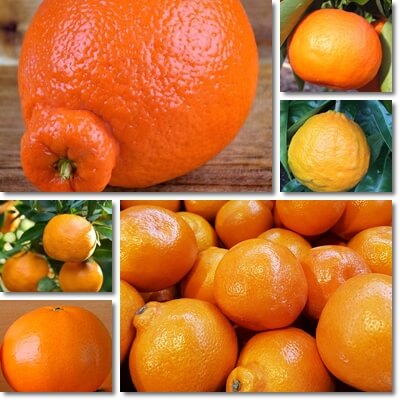If you like to eat citrus fruit, then you’ve likely had tangelo at least a few times. It might have been Orlando tangelo or Minneola tangelo, the popular Honeybells or even Ugli fruit, if not some other variety. Tangelos are sweet and citrussy, tangy and even bitter, and extremely flavorful. Eating tangelo helps keep teeth and gums healthy, combats nausea, tiredness and fatigue and is good for pregnant women. Even diabetics can eat tangelo safely and enjoy a range of benefits. The citrus fruit is an anti-inflammatory food, rich in antioxidants and anticancer agents, and has anti-aging benefits and benefits for high blood pressure and high cholesterol.
What is a tangelo?
Tangelo refers to any citrus fruit that has resulted from the natural or intentional crossing of mandarins, or mandarin hybrids (e.g. tangerines), and pomelo or grapefruit. Despite commonly being called a tangelo orange, the tangelo is not an actual orange. Tangelo is a citrus fruit that, in fact, has no orange genetic material in it. This is because none of the citrus fruit that hybridize to produce tangelos are botanical oranges. Oranges themselves are a naturally occurring hybrid citrus fruit that has developed from pomelos and mandarins.

What does tangelo look like?
Tangelo isn’t just one citrus fruit, but rather an entire group of genetically related, similarly looking citrus fruits. Different varieties may differ in appearance more or less. Most tangelos are about the size of a common sweet orange, and have a glossy orange or reddish-orange peel with fairly little spongy white pith and juicy, segmented orange flesh, either seedless or with relatively few white pips. The rind has tiny, needlepoint-like indentations. While most varieties are either round and flattened at the poles, or somewhat bell-shaped, varieties such as ugli fruit have a downright deformed appearance.
Tangelo varieties
Orlando tangelo
Orlando tangelos look similar to a tangerine, similar size, roundish, but slightly flattened at the poles and somewhat deflated, with a thin, snug rind and little pith.
Minneola tangelo
Minneola tangelos are larger, about the size of medium oranges, often with a neck at the end with the stem, but not always. The rind is relatively thin which makes the Minneola tangelos easy to peel. The variety is in full season December through February.
Honeybells
Honeybells are a variety of Minneola tangelos. Honeybells are large and bell-shaped, the shape being owed to a prominent neck-like protuberance at the end with the stem. The variety has a thick, bright red-orange rind that is fairly easy to peel. Honeybells are in full season December through February.
Ugli fruit (Jamaican tangelo)
Ugli fruit is actually a variety of tangelo. It has an unusual appearance, in the sense that it’s large and almost deformed, hence its name: ‘ugli fruit’. The rind is thick, green and lemon-yellow, yellow or orange, rough and bumpy. The flesh is a pale yellow to green-yellow and segmented. Ugli fruit is in season December to January in Jamaica, but it can be found in stores up until April.
See the benefits of ugli fruit.

Tangelo season
When are tangelo oranges in season? Seasonality differs according to cultivar and region of cultivation. Some tangelo varieties are available September through December, while others are in season December through April. Similarly, tangelos may be in season late fall to late spring (roughly mid-September/October-December to April-May), or only for a short period of time, such as December-February or December-April.
What does tangelo taste like?
All tangelos have more or less the same parentage: mandarins, or mandarin hybrids, and pomelo or grapefruit. But genetic material from the parent citrus fruits differs from one variety to another which also impacts taste. For example, tangelo varieties with mandarin and pomelo parentage can be sweet and low-acidic. Tangelos with mandarin and grapefruit parentage can be sweet and also somewhat bitter. However, taste is not just inherited and goes beyond cultivar. For example, a tangelo that is already ripe in fall-winter tends to taste tangier, whereas a tangelo that is exposed to winter cold tends to taste sweeter.
Honeybells are the sweetest tangelo, low in acidity and pleasant to eat. Ugli fruit on the other hand are barely sweet, with pleasant bitter flavors inherited from its parent, the grapefruit, and only a light tanginess. Minneola tangelos are also generally sweet and low-acidic. Orlando on the other hand taste tangier, but also sweet. Some of the best tasting tangelos are available during peak season which is, for the most part, November/December-January/February. Tangelos are also extremely aromatic, with strong zesty orange flavors, and tend to have lots of juice.
Tangelo nutritional information
Tangelos have an overall modest nutritional value, in line with the nutrition of mandarins, tangerines and oranges. Tangelos provide around 30% of the daily recommended intake of vitamin C per 100 g of raw fruit. Other notable essential vitamins and minerals in tangelo oranges include vitamin B6 (6% of RDI, recommended daily intake for an average adult), vitamin B1 (5%), vitamins B5, B9 and A, calcium and potassium (4%), vitamins B2, B3, magnesium and phosphorus (3%). The citrus fruit are almost sodium-free and contain trace amounts of vitamin E, manganese, iron and zinc. Tangelos have over 50 kcal per 100 g and over 13 g of carbs, of which about 10.5 g natural sugars and 1.8 g dietary fiber.
What are the benefits of tangelo oranges?
Good food to eat for hypoglycemia
Hypoglycemia is a state of abnormally low blood sugar levels that results in symptoms such as lightheadedness, dizziness, muscle weakness and generalized weakness accompanied by a fainting sensation, but also irritability, palpitations and cold sweats. Eating a tangelo quickly brings back blood sugar levels to normal and combats associated side effects, restoring good mood and energy levels.
Helps you lose weight
Even with over 10 g of sugar and over 13 g of carbs per 100 g, tangelos are still a good food to eat if you are looking to lose weight. Tangelos are low in calories (only about 50 kcal/100 g) and very low in fat (about 0.3% fat), but a source of essential vitamins, minerals, anti-inflammatory and antioxidant components that promote good health.
Minor laxative properties
Getting enough fruit and vegetables in your diet helps combat constipation naturally. Eating tangelos provides dietary fiber which helps regulate transit time and promotes easy and regular bowel movements.
Good food to eat for nausea
Tangelo is a good food to eat for nausea because it’s just the right combination of sweet and tangy and can be very refreshing, without further inducing nausea. Vitamin C along with the naturally occurring organic acids in the fruit can also actively combat nausea and help restore appetite.
Anti-aging benefits for skin
The tangelo is a great natural source of vitamin C. Vitamin C stimulates the production of collagen, a structural protein that is responsible for skin elasticity. Getting enough vitamin C in your diet, from both natural sources such as tangelos, and dietary supplements, helps boost production of collagen for better skin elasticity and fewer wrinkles, helping achieve a more youthful skin.
Anticancer properties
Tangelos contain vitamin C and hesperidin which studies show exert anticancer effects via immunomodulatory, antimutagenic, anti-inflammatory and apoptosis-inducing properties. Research shows vitamin C targets many of the mechanisms that cancer cells utilize for their survival and growth (source). The reported anticancer effects of hesperidin have been found to be associated with its anti-oxidant and anti-inflammatory activities, inducing apoptosis and cell cycle arrest, inhibiting tumor cell metastasis, angiogenesis, and chemoresistance (source).
Naturally anti-inflammatory food
Tangelo oranges contain vitamin C and antioxidant flavonones with scientifically proven anti-inflammatory properties. Vitamin C is shown to lower levels of several inflammation markers (e.g. C-reactive protein), and help reduce inflammation in the body. The flavonone hesperidin in tangelos has been shown to also exert anti-inflammatory effects (source). Hesperidin is found in the spongy white part of citrus fruit, also known as albedo or pith, as well as juice and even rind.
Antibacterial, antiviral, antifungal properties
Vitamin C occurs naturally in tangelo, flesh and juice, and is a source of antibacterial, antiviral and antifungal effects. Antioxidants such as naringenin and other flavanones and bioactive compounds in tangelo flesh, juice and pith also exert antibacterial, antiviral and antifungal effects. Tangelo peel is a source of aromatic volatile organic compounds with an antimicrobial and antifungal action.
Good for high cholesterol
Studies show hesperidin in tangelo oranges and other citrus fruit has cholesterol-lowering properties (source). Hesperidin is found in the spongy white pith or albedo of citrus fruit, as well as juice. Vitamin C in tangelos is a source of additional cardiovascular benefits, helping keep arteries clean of plaque and contributing to anti-atherosclerotic benefits.
Benefits for high blood pressure
Magnesium and potassium in tangelos actively lower blood pressure numbers, contributing to cardiovascular health. But the whole fruit is only a modest source of the two minerals and electrolytes. Tangelo juice however has a higher content of both magnesium and potassium and is thus better for blood pressure control.
Benefits for anemia
Eating tangelo is good for anemia, but not because of a high content of iron or B vitamins such as vitamins B9 or B12 (there actually isn’t any B12 in tangelos). Instead, the citrus fruit is a generous source of vitamin C which boosts absorption of iron from other food sources, indirectly contributing to benefits for anemia. If you have anemia, you can eat a tangelo after having meat or eggs to boost iron absorption.
Benefits for pregnant women
Eating tangelo is good for you if you are pregnant. The citrus fruit provides vitamin C which boosts absorption of iron and helps combat tiredness and fatigue associated with pregnancy. Vitamin C is also good for teeth and gums, an aspect of health requiring particular attention during pregnancy. Tangelo also provides small amounts of vitamins B1, B2, B3, B5, B6 and B9 which help combat anemia and support the expanding circulatory system of the pregnant woman. Vitamin B9 in particular is good during pregnancy because it prevents defects of the brain, spine and spinal cord in babies. Small amounts of magnesium and potassium in tangelo and tangelo juice help lower high blood pressure numbers during pregnancy.
Good diabetic food
Tangelo oranges are a good and safe food to eat for diabetics in the sense that they are a low GI food with a glycemic index score of around 40. What this means is the reasonable intakes do not cause spikes in blood sugar levels in diabetics. Tangelos will, however, raise blood sugar which is why it’s important to keep to small intakes.
Tonic, restorative food
Tangelos are high in water and help combat dehydration and loss of fluids as a result of vomiting or diarrhea. The natural sugars in the fruit raise blood sugar levels for quick energy. B vitamins and dietary minerals in the citrus fruit have a tonic, restorative action.
What are the side effects of eating tangelo?
Tangelos are generally safe to eat and do no carry any contraindications when consumed in normal food amounts. While side effects are possible, as is the case for any food, they tend to be very rare and/or minor, usually self-resolving, primarily associated with excessive intakes.
